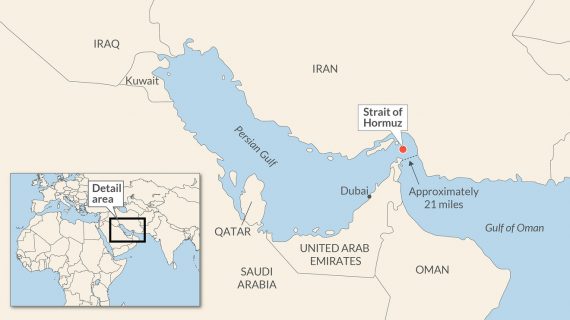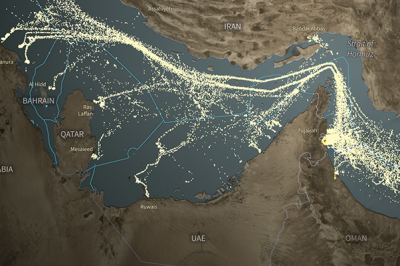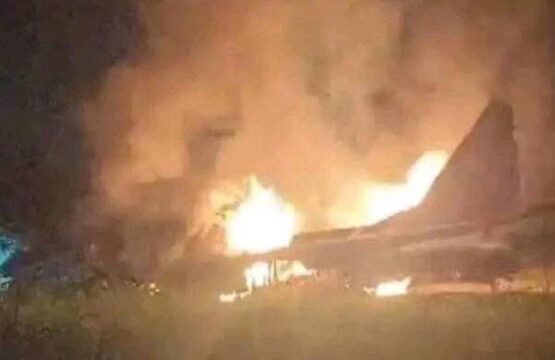What are SMPTS?
Strategic maritime transport passages (SMTPs) are geographically critical chokepoints or waterways. Important SMTPs are the Strait of Hormuz, Malacca, the Suez Canal, the Panama Canal, and Bab el Mandeb. These passages play a crucial role in international trade and transportation. They not only facilitate trade but also have military and strategic consequences. Due to their impact on essential power domains, countries have vested interests in these passages. Therefore, they can be utilized as strategic tools during political or economic friction.
Strait of Hormuz

The Strait of Hormuz is one of the crucial SMPTs. Situated between the Persian Gulf and Oman, it connects the Persian Gulf and Arabian Sea to the Indian Ocean. The Strait of Hormuz is a highly narrow chokepoint. It is only 21 miles (33 km) at its most limited and 60 miles (95 km) at its broadest. The waters are too shallow for oil tankers to navigate the entire Strait. Therefore, the shipping lanes are significantly narrower, about two miles (three km) wide in either direction. It has borders with Oman and the United Arab Emirates to the south and Iran to the north.
Why strait is important?
The Strait’s strategic importance is because of its crucial position as a global maritime trade route. It is one of the most active waterways in the world. International trade, mainly oil exports from the Gulf region, is carried out through this route. Although alternative outlets for crude oil transportation, such as pipelines and other ports, are available, the export capacity of this alternative is limited and relatively small compared to the Strait of Hormuz.
About 21% of the world’s oil and 1/3 of all oil traded internationally transit through this Strait, which makes it a pivot for international trade and a vital factor in shaping global economic dynamics. Because of its immense significance, the vulnerability to geopolitical shifts, power struggles, political rifts, and regional conflicts.
US-Iran in Strait of Hormuz
The United States of America and Iran are two of the main stakeholders in the Strait. The actions of these states shaped the security landscape of Strait. Historically, the rift among both has caused a security threat in the Strait. Because of the geostrategic importance of the Strait, both countries use their resources to maintain influence.
Also Read: Unemployment – A Universal Challenge and Economic Burden
How Strait is important for Iran and the USA?
Iran has massive stakes in the Strait because of its proximity. The geographical proximity to the Strait allows Iran to leverage the Strait of Hormuz as a strategic tool. It also enhances Iran’s standing on the global stage. Because of the strategic importance of the Strait, Iran exercises control over it.
The northern coastline of the Strait of Hormuz, including Iran, controls the entrance and exit points. Iran maintains its security in the Strait through its naval forces. Along with geostrategic importance, the Strait also has geo-economic significance to Iran. As an oil-producing country, Iran depends on the Strait of Hormuz for exports and trade in general.
The USA also holds a significant presence in the Strait. The Strait of Hormuz has strategic and economic significance for the United States. Most of the USA’s oil imports from Gulf countries are carried out through this maritime passage. In 2022, about 11% of the United States of America’s crude oil and condensate imports and 3% of U.S. petroleum liquids are imported through the Strait of Hormuz. Because of the threat from Iran, the U.S. maintains its military presence in the Strait to have an interrupted trade of fossil fuels.
Hence, the Strait carries strategic importance for both the U.S. and Iran. The relations between both countries directly impact the security and stability of the Strait.
US-Iran Rift
Historically, the relationship started going down the road after the Iranian Revolution 1979. After that, the Gulf War of the 1980s and sanctions because of Iran’s nuclear weapons further deteriorated the relations.
Later attempts to normalize relations through the Joint Comprehensive Plan of Action (JCPOA) in 2015 were made by the Obama administration, and, with it, the sanction was lifted. But this process was derailed when Donald Trump unilaterally pulled out of JCPOA in 2018. By imposing sanctions, trump adopted a confrontation strategy with Iran, which marked the beginning of military escalations with Iran. In response to threats from the United States to completely halt Iran’s oil exports, President Hassan Rouhani suggested in July 2018 that Iran may obstruct oil transport across the Strait.
A Nation of Terror
About a month after four commercial ships were damaged in the same area, on June 13, strikes targeted two oil tankers near the Strait of Hormuz. Iran is held accountable by the United States for the assaults, and President Trump has called Iran “a nation of terror.” In retaliation, the United States announced it would send an extra thousand troops to the Middle East.
The Islamic Revolutionary Guard Corps (IRGC) shot down an American surveillance drone two days later. U.S. claims once more that Iran is responsible for strikes on nearby oil ships and attempts to capture an Iranian boat that is making its way close to the British enclave of Gibraltar. The U.S. military reported an incident with an Islamic Revolutionary Guard Corps Navy boat approaching American warships in the Strait to within 150 yards in December 2022.
Following this, Iran took control of two oil tankers traveling through the Strait in May 2023. The U.S. Navy then intervened in July 2023 to stop Iran from taking two commercial tankers in the Gulf of Oman. These incidents show the rising confrontational relations between Iran and the United States and threats to the security and stability of the Strait.
The Negev Forum
In March, 2022United States, to deter Iran’s increasing threat, allied with Bahrain, Egypt, Israel, Morocco, and the United Arab Emirates (UAE) to establish the Negev Forum. This collaborative framework aims to address a spectrum of regional goals, extending beyond defense, with a notable emphasis on deterring Iran.
Meanwhile, emphasizing emerging concerns about Iran’s drone and missile programs, the U.S. arranges a covert meeting. Military officers from Bahrain, Egypt, Israel, Jordan, Qatar, Saudi Arabia, and the United Arab Emirates are holding secret meetings to plan and coordinate countermeasures against Iran’s expanding threats involving unmanned aerial vehicles and ballistic missiles. This clandestine conference represents a coordinated regional effort to tackle common security issues.
Israel-Palestine Conflict
Another incident that adds fuel to the fire is the Israel-Palestine conflict—a war outbreak between Iran-backed Hamas and Israel on October 7, 2023. The United States and other Western countries backed Israel in this war, while Iran supported Hamas and called on Muslim nations to ban oil exports to the West, especially the USA.
Since the conflict, tensions in the Strait have been going on. While trade through the Strait has not been significantly affected, skirmishes in Yemen have been ongoing. Because of that, there is the threat of Iran blocking the waterway. The United States is also trying to engage other stakeholders to form a coalition to counter Iran’s threat.
A senior White House official said: “We know that Iran was deeply involved in planning the operations against commercial vessels in the Red Sea. This is consistent with Iran’s long-term material support and encouragement of the Houthi’s destabilizing actions in the region. This is an international challenge that demands collective action”.
The United States, in the past, has also tried to form a front against Iran, but this time, Because of the Israel-Palestine conflict, tension is more. In his statement, Iran’s defense minister responding to the threat warned the U.S. He said: “If they make such an irrational move, they will be faced with extraordinary problems. Nobody can make a move in a region where we have predominance”.
Tanker War
Keeping in view the history, the 1973 oil embargo targeting Canada, Japan, the Netherlands, Britain, and the United States imposed an oil embargo on Western allies of Israel in its conflict with Egypt under the leadership of Saudi Arabia. This might have disastrous effects on Western economies, particularly the U.S. If the conflict further extends, it might lead to the closure of the Strait of Hormuz.
According to JPMorgan, “If the conflict broadens to include the closure of the Strait of Hormuz, the world’s busiest oil-shipping channel, it would shut down the region’s oil trade, supercharging oil prices.”
Conclusion
In conclusion, the Strait of Hormuz is an important Strategic maritime transport passage. International trade and economy depend on its stability. Because of its geostrategic and geo-economic importance, multiple actors, especially Iran, and the U.S., have stakes in it. Any aggression in the Strait might lead to a prolonged conflict at the regional and international levels. Therefore, there is a need for negotiation and dialogue among actors to avoid conflict and maintain stability in the Strait.







